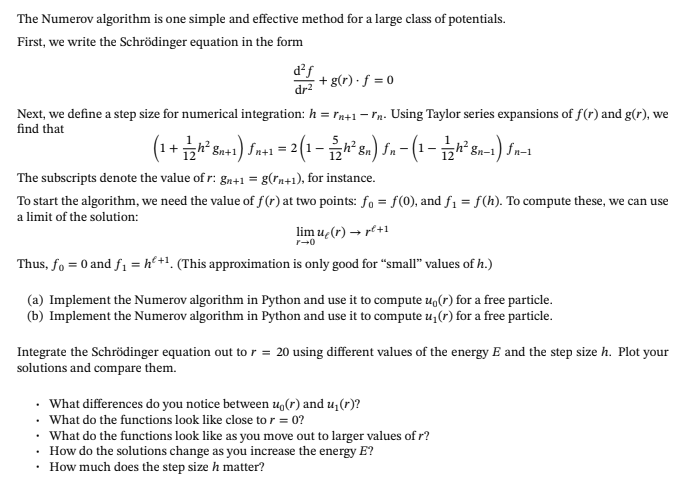Answered step by step
Verified Expert Solution
Question
1 Approved Answer
need a and b in python code. The Numerov algorithm is one simple and effective method for a large class of potentials. First, we write



need a and b in python code.
The Numerov algorithm is one simple and effective method for a large class of potentials. First, we write the Schrdinger equation in the form df + g(r). f = 0 dra Next, we define a step size for numerical integration: h = rn+1-rn. Using Taylor series expansions of f(r) and g(r), we find that (1 + ? En+1) fn+1 = 2 (1 - ik? gn) fn- (1 - izu? 8.-) fn- The subscripts denote the value of r: En+1 = g(n+1), for instance. To start the algorithm, we need the value of f(r) at two points: fo = f(0), and f1 = f(h). To compute these, we can use a limit of the solution: limu (r) pl+1 Thus, fo = 0 and f1 = he+1 (This approximation is only good for small values of h.) -0 (a) Implement the Numerov algorithm in Python and use it to compute uo(r) for a free particle. (b) Implement the Numerov algorithm in Python and use it to compute u (r) for a free particle. Integrate the Schrdinger equation out to r = 20 using different values of the energy E and the step size h. Plot your solutions and compare them. What differences do you notice between u (r) and u_(r)? . What do the functions look like close to r = 0? What do the functions look like as you move out to larger values of r? How do the solutions change as you increase the energy E? How much does the step size h matter? cos kr jo(kr) = sin kr kr and ji(kr) sin kr (kr) kr uo(r) = kr jo(kr) u(t)= kr ji(kr) The Numerov algorithm is one simple and effective method for a large class of potentials. First, we write the Schrdinger equation in the form df + g(r). f = 0 dra Next, we define a step size for numerical integration: h = rn+1-rn. Using Taylor series expansions of f(r) and g(r), we find that (1 + ? En+1) fn+1 = 2 (1 - ik? gn) fn- (1 - izu? 8.-) fn- The subscripts denote the value of r: En+1 = g(n+1), for instance. To start the algorithm, we need the value of f(r) at two points: fo = f(0), and f1 = f(h). To compute these, we can use a limit of the solution: limu (r) pl+1 Thus, fo = 0 and f1 = he+1 (This approximation is only good for small values of h.) -0 (a) Implement the Numerov algorithm in Python and use it to compute uo(r) for a free particle. (b) Implement the Numerov algorithm in Python and use it to compute u (r) for a free particle. Integrate the Schrdinger equation out to r = 20 using different values of the energy E and the step size h. Plot your solutions and compare them. What differences do you notice between u (r) and u_(r)? . What do the functions look like close to r = 0? What do the functions look like as you move out to larger values of r? How do the solutions change as you increase the energy E? How much does the step size h matter? cos kr jo(kr) = sin kr kr and ji(kr) sin kr (kr) kr uo(r) = kr jo(kr) u(t)= kr ji(kr)Step by Step Solution
There are 3 Steps involved in it
Step: 1

Get Instant Access to Expert-Tailored Solutions
See step-by-step solutions with expert insights and AI powered tools for academic success
Step: 2

Step: 3

Ace Your Homework with AI
Get the answers you need in no time with our AI-driven, step-by-step assistance
Get Started


